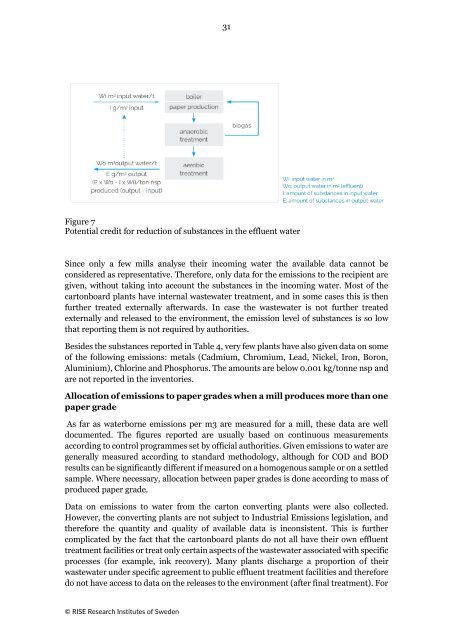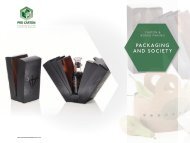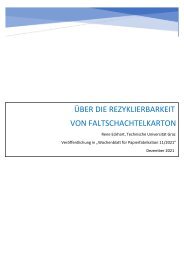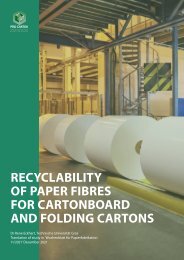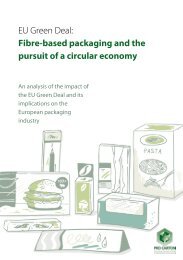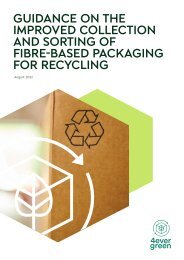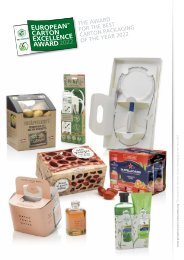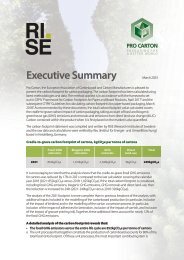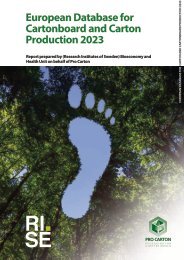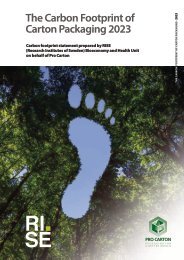European database for cartonboard and carton production, 2023
You also want an ePaper? Increase the reach of your titles
YUMPU automatically turns print PDFs into web optimized ePapers that Google loves.
28<br />
Transport<br />
The transport distances of wood raw materials from the harvesting sites in the <strong>for</strong>ests to<br />
the mills have been reported separately <strong>for</strong> trucks, rail <strong>and</strong> ships. The trucks <strong>and</strong> rail<br />
wagons are normally loaded to full capacity but go back empty. The trucks carry 40-44<br />
tonnes of wood. This in<strong>for</strong>mation has been collected on a species-by-species basis <strong>for</strong><br />
each mill, considering the wet weight of the wood. Data has also been collected <strong>for</strong> the<br />
delivery of sawmill residues <strong>and</strong> similar sources of fibre. Distances <strong>and</strong> tonnages of wood<br />
delivered have then been used to calculate the total t.km <strong>for</strong> delivery of wood by each<br />
mode of transport (truck, rail <strong>and</strong> boat). This is then used to calculate the t.km/t of<br />
<strong>production</strong> <strong>for</strong> each grade at each mill, calculated on a mill-by-mill, input-by-input basis.<br />
A weighted average t.km is then calculated based on the relative <strong>production</strong> share of each<br />
mill.<br />
A similar approach is applied <strong>for</strong> calculating the transport requirements <strong>for</strong> recovered<br />
paper. Transport distances from point of origin of the recovered paper bales to the mills<br />
have been reported on a recovered paper grade-by-grade basis <strong>for</strong> each mill. Distances<br />
<strong>and</strong> tonnages of recovered paper delivered have then been used to calculate the total t.km<br />
<strong>for</strong> delivery of recovered paper by each mode of transport (truck, rail <strong>and</strong> boat). This is<br />
then used to calculate the t.km/t of <strong>production</strong> <strong>for</strong> each grade at each mill, calculated on<br />
a mill-by-mill, input-by-input basis. A weighted average t.km is then based on the<br />
relative <strong>production</strong> share of each mill. Generally, the lorries are loaded to full capacity.<br />
On the return trip it is estimated that 40% of the trucks return empty. Assuming this is<br />
transported by a truck with a loading capacity of 40 tonnes this means that this figure<br />
has to be used in combination with data on inputs <strong>and</strong> outputs <strong>for</strong> transport by a 40t<br />
truck.<br />
Similar data has also been collected <strong>and</strong> applied to estimate the transport associated with<br />
non-fibre inputs. Transport data has been collected <strong>for</strong> the most important non-fibre<br />
inputs (sulphuric acid, sodium hydroxide, oxygen, hydrogen peroxide, sodium chlorate,<br />
calcium oxide, chlorine dioxide, sodium bisulphite, synthetic binders (latex), ground<br />
calcium carbonate, precipitated calcium carbon (purchased), clay, wet strength, AKD<br />
sizer, <strong>and</strong> starches).<br />
Data has also been collected regarding the average transport of the residues from the<br />
paper mill to the residue treatment process. Where no data was available relating to the<br />
transport distance <strong>for</strong> selected residue streams, a worst case scenario of 100km is<br />
assumed.<br />
Data was also collected from the papermills on average delivery distances <strong>and</strong> modes of<br />
transports to their customers. This data was provided on a product-by-product basis <strong>and</strong><br />
was used to calculate a weighted average t.km <strong>for</strong> delivery of <strong><strong>carton</strong>board</strong> to the <strong>carton</strong><br />
converting plants. However, any one <strong>carton</strong> converting plant will of course source the<br />
substrates they use from many different suppliers. There<strong>for</strong>e, the values presented in the<br />
inventory are only indicative <strong>and</strong> in practice users of the data may wish to consider<br />
delivery of materials on a case-by-case.<br />
Internal transport is included in the energy input.<br />
© RISE Research Institutes of Sweden


